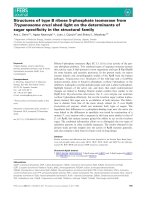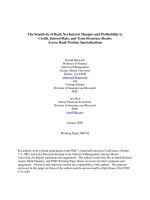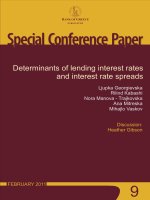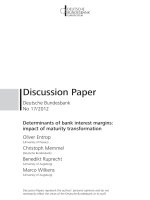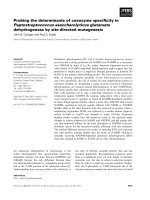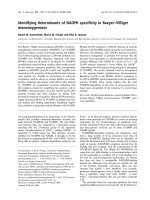The determinants of net interest margins in asean banks in the period 2008 – 2012
Bạn đang xem bản rút gọn của tài liệu. Xem và tải ngay bản đầy đủ của tài liệu tại đây (366.35 KB, 82 trang )
UNIVERSITY OF ECONOMICS
INSTITUTE OF SOCIAL STUDIES
HO CHI MINH CITY
THE HAGUE
VIETNAM
THE NETHERLANDS
VIETNAM – THE NETHERLANDS
PROJECT FOR M.A ON DEVELOPMENT ECONOMICS
THE DETERMINANTS OF BANK INTEREST
MARGINS IN ASEAN BANKS IN THE PERIOD
2008 – 2012
BY
VAN THI THANH NHAN
MASTER OF ARTS IN ECONOMICS OF DEVELOPMENT
HO CHI MINH CITY – DECEMBER 2014
UNIVERSITY OF ECONOMICS
INSTITUTE OF SOCIAL STUDIES
HO CHI MINH CITY
THE HAGUE
VIET NAM
THE NETHERLANDS
VIETNAM – NETHERLANDS
PROGRAMME FOR M.A IN DEVELOPMENT ECONOMICS
------------------------------------------THE DETERMINANTS OF NET INTEREST MARGIN IN ASEAN BANKS
IN THE PERIOD 2008 - 2012
By
VAN THI THANH NHAN
MASTER OF ARTS IN DEVELOPMENT ECONOMICS
Ho Chi Minh City, December 2014
-1-
UNIVERSITY OF ECONOMICS
INSTITUTE OF SOCIAL STUDIES
HO CHI MINH CITY
THE HAGUE
VIET NAM
THE NETHERLANDS
VIETNAM – NETHERLANDS
PROGRAMME FOR M.A IN DEVELOPMENT ECONOMICS
------------------------------------------THE DETERMINANTS OF NET INTEREST MARGIN IN ASEAN BANKS
IN THE PERIOD 2008 - 2012
A thesis submitted in partial fulfilment of the requirements for the degree of
MASTER OF ARTS IN DEVELOPMENT ECONOMICS
By
VAN THI THANH NHAN
Academic supervisor
Dr. NGUYEN TRONG HOAI
Ho Chi Minh City, December 2014
-2-
CERTIFICATION
I hereby assure that the thesis “The determinants of net interest margin in Asean
banks in the period 2008 – 20012” was made by me under supervisor of Dr. Nguyen
Trong Hoai.
I also certify that data and results of this thesis are honest and have not published
by anyone. In addition, the substance of the thesis has not been submitted for any other
degrees.
VAN THI THANH NHAN
-3-
ACKNOWLEDGEMENT
In the process of researching is not always convenient and smooth as expected.
Sometimes, when I faced with difficulties and challenges I wanted to give up without
support, help and encouragement of whose are always by my side. Hence, before I
introduce the content of this paper I want to send to my loved ones deepest gratitude.
To my parents and my big family who are always beside and have instructed me
on my ways whenever I am failure or successful.
To my beloved husband who always encourage, motivate me not only in the
process of completing this study but also in the life. Thank you, love you so much.
To my beloved daughter, thanks my angel who has given me the impetus from
love and responsibility so that I can awake at night and work hard. Thanks for helping me
forget all the fatigue and back down when I look at you.
Thank to Dr. Nguyen Trong Hoai who has always supported me in this process.
Thanks for your reminder and encouragement so that I could complete this paper.
Especially, thank for giving me can feel the love and confidential teacher.
To the Doctors, tutors in VNP program have imparted knowledge with all of
passion, enthusiasm. Thanks to the other employees, students in the program support me
when I study in VNP program.
To the friends, colleagues has supported and facilitated during the completion of
this research.
VAN THI THANH NHAN
-4-
TABLE OF CONTENTS
Certification .............................................................................................................. 3
Acknowledgement .................................................................................................... 4
List of figures............................................................................................................ 8
List of tables ............................................................................................................. 9
Abbreviations.......................................................................................................... 10
Abstract................................................................................................................... 11
CHAPTER 1: INTRODUCTION
1.1 Problem statements........................................................................................... 12
1.2 Research objectives .......................................................................................... 17
1.3 Research questions ........................................................................................... 18
1.4 Research scope ................................................................................................. 18
1.5 Research structure............................................................................................. 18
CHAPTER 2: LITERATURE REVIEW AND CONCEPTUAL FRAMEWORK
2.1 Literature review for interest margins .............................................................. 19
2.1.1 Definition of net interest margin ............................................................ 19
2.1.2 Determinants of NIM.............................................................................. 21
2.1.2.1 Related literature ............................................................................. 21
2.1.2.2The macroeconomic factors.............................................................. 23
2.1.2.3The bank specific factors .................................................................. 24
2.1.2.4 The banking market factor ............................................................... 27
-5-
2.2. The suggested research approach .................................................................... 32
2.3. The concept framework
............................................................................ 34
CHAPTER 3: RESEARCH METHODOLOGY AND DATA COLLECTION
3.1 Identification of variables ................................................................................ 36
3.1.1 The dependent variable........................................................................... 36
3.1.2 The independent variables and hypothesis testing ................................ 36
3.1.2.1 The macroeconomic factors ........................................................ 36
3.1.2.2 The banking market factor .......................................................... 38
3.1.2.3 The banking specific factors ....................................................... 38
3.2 Data collection and expected results ............................ ...................................... 43
3.3 The research methodology ................................................................................... 45
3.3.1 The model ................................................................................................... 45
3.3.2 The estimation method ............................................................................... 45
3.3.2.1 Fixed Effect Model.......................................................................... 45
3.3.2.2 Random Effect model .................................................................... 47
3.3.2.3 Selecting the appropriate model ..................................................... 48
3.4 The outline of estimation method......................................................................... 48
CHAPTER 4: DATA ANALYSIS AND DISCUSSION
4 .1 Descriptive statistical analysis......................................................................... 50
4.1.1 The data description ............................................................................. 50
4.1.2 The summary statistic .......................................................................... 51
4.1.3 Testing for correlation relationship ...................................................... 54
-6-
4.1.4 Checking for multicollinearity ............................................................. 54
4.1.5 The relationship between independent variables and
Net interest margins ...................................................................................... 55
4 .2 Econometric estimation and testing models: .................................................. 61
4.2.1 Whether FEM or REM is more consistent ........................................... 62
4.2.2 Fixed Effects Model ............................................................................. 63
4.3 Empirical findings ........................................................................................... 65
4.3.1 Hypothesises rejected .................................................................................... 65
4.3.2 Hypothesises accepted................................................................................... 65
CHAPTER 5: CONCLUSION AND RECOMMENDATIONS
5.1 Conclusion ........................................................................................................ 68
5.2 Policy Recommendation................................................................................... 69
5.3 Limitation and further research ........................................................................ 71
REFERENCES ..................................................................................................... 72
APPENDIX A........................................................................................................ 77
APPENDIX B ........................................................................................................ 79
-7-
LIST OF FIGURES
FIGURE 1: GDP growth rate in main regions and countries, 2005 – 2009 ...................14
FIGURE 2: The growth rate of worldwide industrial exports, 2005 – 2009. .................15
FIGURE 3: GDP growth rate from 2008 to 2009 in Asean countries ............................16
FIGURE 4: Inflation rate from 2008 to 2012 in Asean countries...................................16
FIGURE 5: Trend of Net Interest Margins in Asean banks from 2008 – 2012..............17
FIGURE 6: The relationship between GDP and NIM ....................................................56
FIGURE 7: The relationship between INF and NIM......................................................56
FIGURE 8: The relationship between HHI and NIM .....................................................57
FIGURE 9: The relationship between SIZE and NIM....................................................57
FIGURE 10: The relationship between LIQ and NIM ...................................................58
FIGURE 11: The relationship between CRD and NIM ..................................................58
FIGURE 12: The relationship between CAP and NIM .................................................59
FIGURE 13: The relationship between OPE and NIM...................................................59
FIGURE 14: The relationship between IIP and NIM .....................................................60
FIGURE 15: The relationship between MGE and NIM ................................................ 60
-8-
LIST OF TABLES
Table 1: Feature and source of variables ......................................................................43
Table 2: Data description..............................................................................................50
Table 3: Deterministic statistic of main variables ........................................................51
Table 4: Correlation coefficient of variables ...............................................................54
Table 5: Testing for multicollinearity...........................................................................55
Table 6: Comparison of regression result of FEM and REM.......................................61
Table 7: Testing for selecting appropriate model.........................................................62
Table 8: Results of Fixed Effect Estimator ..................................................................63
Table A: The summary of main literatures review...................................................... 28
-9-
ABBREVIATIONS
ASEAN
: Association of Southeast Asian Nations ............................................... 11
GDP
: Gross domestic product .....................................................................17
CEE
: Central and Eastern Europe ..................................................................22
CPI
: Consumer Price Index
FEM
: Fixed Effect Model .............................................................................11
REM
: Random Effect Model .........................................................................11
WB
: Work Bank ..........................................................................................11
IMF
: International Monetary Fund ...............................................................14
LSDV
: Least Square Dummy Variable ............................................................46
FGLS
: Feasible Generalized Least – Squares .................................................46
.....................................................................37
- 10 -
ABSTRACT
This study investigates the determinants of bank interest margins in Association of
Southeast Asian Nations (Asean) banks over the period 2008 – 2012 by using of a panel
data set. In this research, the Hausman test will be used to make my choice is (FFM)
Fixed Effect model or Random Effect model (REM) to analyze impact factors on the net
interest margins (NIM). In addition, the data serving for research come from the World
Bank (WB) Indicators database and Bankscope database. According to the expected
results, there will be three main group impacts on bank margins: the bank specific
characteristics, the macroeconomic conditions, the banking market characteristics. The
results do not indicate that macroeconomic factors and structure of market have any
impact on net interest margins. In the banking characteristics, the paper finds that there is
only capital adequacy, implicit interest payment and managerial efficiency effecting on
bank margins. Based on these findings, the policy makers can advance petitions and
policies for managing bank margins effectively following developing strategy of banks
by controlling significant effects on bank margins; namely capital adequacy, implicit
interest payment and quality of management.
Keyword: Net interest margins, determinants, Asean, bank.
- 11 -
CHAPTER 1: INTRODUCTION
1.1 PROBLEM STATEMENTS:
Bank systems play a cruel role in the modern economy, banks are considered as
intermediate institutions in social. Efficiency of financial intermediaries influences on
developing economy with specifics example in India (Sathye, 2003). As a good example,
development and efficient of banking system impacted on Hungarian economy in
transitional period (Hasan & Marton, 2003). On the other hand, the banking sector plays
important role in monetary policy in Europe through deposit and lending channel,
(Kashyap & Stein,1997), this paper proclaim that the degree of bank dependence on
customers and ability of bank are main factor on setting up monetary for the European
monetary union The more efficient banking systems, the better economy stand shock.
Similarly, efficiency of banking system is an important part in stabilizing economy
(Athanasoglou, Brissimis and Delis, 2005) and (Sbracia & Zaghini, 2003). At the same
time, the banking sector is seen as a bridge between the different sectors of the economy,
the economic bridge between regions and nation together. Because of the important role
of the banking system, the performance of the banking system has been considered one of
the important issues in the country’s economy in particular and the world economy in
general. Bank activities in many different fields such as deposits, credit, banking services,
money transfers,… and the other finance fields securities, real estate, etc. However, the
activities which bring main profit for bank are deposit and lending, they are seem a
specific areas of banking system. Hence, Banks play a crucial role as the financial
intermediary.
The traditional business operation of bank is that loans and deposits, bank collects
funds from customer’s deposit and meet demand loans base on this funds, so when the
cost of fund is high, it will effect on bank profitability. Net interest margin is supposed a
typical indicator for relationship between deposits and loans of bank. NIM can be
- 12 -
measured by two ways. In the first method, NIM is calculated by difference between loan
interest rates and deposit rates. According the second way, NIM is measured by the
difference between interest income and interest expenses of bank divide by total assets
for the period considered, data of interest income and interest expenses, total assets
usually get from the financial statement. The interest income stands for the result of bank
after taxes for the period surveyed, the interest expenses is represented the cost of
depositing funds in the current period. In general, the second method was used in most
previous studies on the NIM such as Ho and Saunders (1981), Angbazo (1997), Saunders
and Schumacher (2000), etc and most NIM published by banks is calculated income
statement based on the second method.
As for the impact of NIM on banking operation, Demirgüç-Kunt and Huizinga
(1999) reply that the largely on deposits for fund will have less profitability because
covering the cost of funds increase, they also found that stable and efficient bank
concentrate on banks margins and profitability, the bank interest margins should not be
too large. Typical representative of banking cost and efficiency is net interest margins. As
most of previous studies, the net interest margin is calculated as the gap between interest
income and interest expense by percent of total earning assets will influence on bank’s
efficiency. As a result, NIM can be used an indicator of the banking sector. At the same
time, an efficient intermediation cost as indicated by a low rates of net as well as reflects
the effectiveness of monetary policy and financial stability (Hadad et al, 2003). By
contrast, high costs would reduce the incentive for economic actors. Raharjo et al (2014)
proved that the banking sector is heathy and able to create more profit, it will can to
withstand shocks and contribute to the stability of financial system. In a country, the
financial sector is dominated by banking sector, any failure in this sector has an immense
implication on the economic growth of the country. Hence, as a fact, any bankruptcy or
poor performance in banking sector has a contagion effect that can lead to bank runs,
crises and bring overall financial crisis and economic tribulations (Ongore and Kusa,
2013). Therefore, this research wants to analyze the determinants of net margin in the
- 13 -
financial period, so that can found significant factor and base on that to improve heath of
bank through net interest margins.
In the period 2008 -2012, the global economy was under pressure from the financial
crisis in the United State at all sectors such as industry, services, finance,…Especially,
the banking sector was affected significantly by this crisis. For example, bankrupt of
several large American banks as Lehman Brothers Bank which was the fourth largest in
United State in 2008, the Integra Bank Corp in 2011 and a lots of smaller bank over the
period 2008 – 2012. The instability of the largest banking system affected whole of
banking system in the world, in which the Asean banks were not exceptional. Period
2008 -2009 was considered as the worst economic crisis of the world economy. The
major economies such as America, Japan and Europe fell into recession, GDP declined
dramatically, unemployment rate increased highly, a lot of companies bankrupt,… Some
countries fell into negative GDP growth as the EU (-0.5%), Germany (-0.8%), the United
States (-0.7%), Japan ( -0.2%)some countries like Russia and only 3 , 5% and China from
10% to 8% in 2008 (Figure 1). In addition, Figure 2 also show that the growth rate of
worldwide industrial exports decreased remarkably from 2007 t0 2009.
Figure 1: GDP growth rate in main regions and countries, 2005 - 2009
14
World
12
Developed countries
GDP (%)
10
European Union
United States
8
Japan
6
Developing countries
4
Brazil
2
Russia
India
0
-2
2005
2006
2007
2008
Year
- 14 -
2009
China
Source: International Monetary Fund (IMF) and Author’s calculation
Figure 2: The growth rate of worldwide industrial exports, 2005 – 2009.
Worldwide industrial exports
10
9
8
7
6
5
4
3
2
1
0
2005
2006
2007
2008
2009
Year
Source: Source: IMF and Author’s calculation
Grigor and Salikhov (2009) discussed the main causes of this crisis, of which high
economic growth rates worldwide since the beginning of the 2000s against the
background of serious savings imbalances; Negative real interest rates in developed
countries; De facto weakening of financial sector regulation with the sudden expanded
use of new financial instruments were main factors of developing the global crises.
Fidrmuc and Korhonen (2010) have demonstrated the powerful impact of the global crisis
on business cycles in Asian developing countries. It found that there was a negative
significant impact between the global crises in 2008 to economic development of OECD
countries, namely decline of GDP growth rate and low level of business cycle were
results of this crisis in OECD countries. Ivashina and Scharfstein (2010), Aisen and
Franken (2010) showed the effect of the crisis on a bank credit which was main activities
of banks. Period 2010 - 2012, the world economy began to recover from the shock of the
crisis still lingers to the crisis.
The crisis developed and spread to other Asian countries, including the countries of
the ASEAN region. In ASEAN countries, Figure 3 showed that GDP growth rate
- 15 -
fluctuations during the period 2008 - 2012, including the period 2008 - 2009 GDP slump.
However, GDP growth rate began to recover over the period 2010 – 2012. Similarly, the
inflation rate also declined dramatically during 2008 – 2009 in most Asean countries, and
in 2010 -2012 the inflation rate became more stable (Figure 4).
Figure 3: GDP growth rate from 2008 to 2009 in Asean countries.
GDP growth rate
8
7
6
5
4
3
2
1
0
2008
2009
2010
2011
2012
Source: Work Bank (WB) and Author’s calculation
Figure 4: Inflation rate from 2008 to 2012 in Asean countries
Inflation rate
10
8
6
4
2
0
2008
2009
2010
2011
2012
Source: WB and Author’s calculation
On the other hand, Figure 5 showed the trend of NIM in Asean banks from 2008 to
2012. NIM is seemed as the proxy of banking efficiency. Hence, fluctuate of NIM will
effect on efficiency, profit of banks. In this crisis period, the net interest margins tend to
decline in Asean countries. The Figure 3 showed the trend of mean NIM in Asean banks
- 16 -
over the period 2008 -2010. The graph shows a downward trend in the epicenter of the
crisis period 2008 – 2010 and during the recovery phase of economy from 2010 – 2010,
NIM has fluctuated. Therefore, this study wants to find out the factors that have affected
the volatility of NIM after the world economic crisis
Figure 5: Trend of Net Interest Margins in Asean banks from 2008 – 2012
4.3
4.2
4.1
4
3.9
3.8
3.7
3.6
2008
2009
2010
2011
2012
:
Source: Bankscope and Author’s calculation
1.2 RESEARCH OBJECTIVES
The goal of the study:
The main goal of this study is to model and measure the significant determinants
of the net interest margins in Asean banks including ten (10) factors: Gross Domestic
Product (GDP) growth rate, Inflation rate, banking market structure (represented by
HHI), Bank size, Liquidity risk, Credit risk, Capital adequacy, Operating cost, Implicit
interest payments, Managerial efficiency. At the same time, to draw empirical conclusion
and suggest some policy recommendations for decision makers.
Specific objectives:
To meet this goal, specific objectives are set out:
1. Determine the factors, magnitude, sign and significant level of determinants of NIM.
2. Inferring conclusions to suggest recommendations.
- 17 -
1.3 RESEARCH QUESTIONS
To solve objective of this paper, the relevant questions are answered:
1. What factors influence on the bank interest margins in Asean banks?
2. How those factors impact on the bank interest margins?
3. To recommend general policies for managing bank interest margins of Asean
banks. Which policy recommendation to manage NIM?
1.4 RESEARCH SCOPE
The study will cover determinants impact on bank interest margins in 9 Asean
countries (Brunei, Cambodia, Malaysia, Philippines, Laos, Vietnam, Singapore, Thailand,
and Indonesia) from 2008 to 2012. In fact, Asean region have 10 members including
Brunei, Cambodia, Malaysia, Philippines, Laos, Vietnam, Singapore, Thailand, Indonesia
and Myanmar. However, there was a limitation of collecting Myanmar data so it will be
eliminated Myanmar from this study.
1.5 RESEARCH STRUCTURE
The rest of the research is organized as follows. Chapter 1 explain reasons of choose
this theme and main goals of research. Chapter 2 outlines the literature reviews and
conceptual framework on the determinants of net interest margins. Chapter 3 describes
the research methodology and data. Chapter 4 presents the main results of analysis.
Chapter 5 concludes and gives some policy recommendation.
- 18 -
CHAPTER 2: LITERATURE REVIEW AND CONCEPTUAL
FRAMEWORK
2.1 LITERATURE REVIEW FOR INTEREST MARGINS
2.1.1 DEFINITION OF NET INTEREST MARGIN:
NIM is preceded from the relationship between deposits and lending at the bank.
The bank mobilize funds of depositors by deposit interest rate giving, after that the bank
invest these funds by giving loans for borrowers with higher interest rate. Net interest
margins analysis is one way of measuring the cost of financial intermediation, the
difference between the cost of interest paid by the borrower to the bank and depositors
received interest income (Brock and Suarez, 2000). So that the bank set up the rates for
loans and deposit as follow:
RL = r + b
RD = r – a
In which:
RL
: the rate on loans
RD
: the rate on deposits
R
: risk – free interest rate
a
: fees charged on loans
b
: fees charged on deposits
And the pure margin is:
RL- RD = a + b
Determinant of net margins can be explained using two approaches, namely the
traditional approach and modern approach. The traditional approach views of variables
that affect the NIM are done by analyzing the balance sheets of bank, whereas the
modern approach by taking into account demand and supply rate on the microstructure of
- 19 -
the bank. Almost previous studies based on modern approach. Therefore, NIM is the
ratio of net interest income to total earning assets of banks and this indicator usually
published by bank report annually. Net interest income is the difference between interest
income and interest cost earned on interest expense paid. A study conducted by Ho and
Saunders (1981) is a pioneer in analyzing the NIM to make banking model as
intermediary between recipient and the channeling of funds. Ho and Saunders (1981)’s
model argue that the bank faces reinvestment risk at the end of the decision period should
the short – term rate fall, hence the fees a and b must compensate the bank for bearing
this interest rate. Hence the fees a and b are optimal and the optimal interest margin is:
(*)
In which:
s
: the difference between lending and deposit rates
/
: bank’s risk neutral spread
Q
: size of bank transactions
2
; the instantaneous variance of the interest rate on deposits and loans
R
: the bank management’s coefficient of absolute risk aversion
Ho and Saunder (1986) defined NIM as the spread between the interest revenue on
bank assets and interest expenses on bank liabilities as a proportion of average bank
assets. Similarly, Dietrich, Wanzenried and Cole (2010) showed that the net interest
margin is the difference between a bank’s interest income and interest expense expressed
as a percentage of interest earning assets. In the study of Raharjo, Hakim, Manurung and
Maulana (2014), NIM is measured by the ratio of the net interest income to average total
earning assets of banks. Net interest income is the difference between interest income and
interest costs earned on interest expense paid while the earning assets that are accounted
for productive assets that generate interest. Besides, net interest margin was specified by
- 20 -
the difference between the cost of interest paid for the borrower and depositors received
interest income in Brock and Suarez (2000)’research. In general, above definitions have
difference phrase but the same meaning about NIM. In this study, NIM will be measured
by the ratio of net interest income to total earning assets, while net interest income is
calculated by interest income minus interest expenses. The database of NIM is provided
by Bankscope so there is an advantage when using Banksope data because of
homogeneousness among the database of NIM across countries.
2.1.2 DETERMINANTS OF NIM
2.1.2.1 RELATED LITERATURE:
Ho and Saunders (1981) is one of first persons who examine about determinants of
net interest margins. The result showed that main determinants of NIM includes interest
rate volatility, size of transactions, risk aversion and market competition by using the two
step regression procedure. In the first step, the NIM was estimated by regression on bank
specific characteristics and in the second steps, NIM was estimated by macroeconomics
and market structures characteristics.
In the dealership model of Ho and Saunders
(1981), the bank plays a role as a risk averse which facing with cost of fund in loans and
deposit markets. There are many studies based on Ho and Saunders (1981)’s model to
analyze net interest margins according to different aspects.
Wong (1997) also extended the model of Ho and Saunders (1981). It found that
credit and interest rate risk are affected on NIM based on the simple firm – theoretical
model. This firm – theoretical model was based on behavior of risk-averse bank with
NIM under credit risk and interest rate risk. The results of this paper gave information
about positive relationship between NIM and market power, operating cost ad credit risk;
simultaneously, there was a positive impact of interest rate risk on bank interest margins.
Relying on the dealership model of Ho and Saunders (1981) , Saunders and Schumacher
- 21 -
(2000) also employed the two step procedure to find impacts on NIM in some countries
are that Germany, Italy, Switzerland, UK, Spain, France, US over the period 1988 – 1995
under implicit interest rate, the opportunity cost and credit risk. On the other hand, Claeys
and Vander Vennet (2008) used random effect estimator to compare different
determinant of NIM between Cemtral and Eastern Europe and the West. The study
examined that interest rate volatility and regulatory restriction such as minimum capital,
liquid reserves requirement, implicit interest rate effected on NIM significantly. Angbazo
(1997) also based on the dealership model of Ho and Sauders (1981), Mcshane and
Sharpe (1985) and Allen (1988) to explore the interest rate risk, default risk, liquidity risk
and off-balance sheet is consistent with fluctuation of NIM for 1989-1993 with 1400
observations on 286 commercial banks from the Call Report data. By contrast, Lin et
al.(2012) applied the switching regression model for their research about banks margins
on diversification at banks in some Asian countries as China, India, Indonesia, Japan,
Philippines, Singapore, South Korea, Taiwan and Thailand from 1997 to 2005. The
findings showed that NIM can be sensitive because of bank risk factors as liquidity risk,
interest rate risk, credit risk, implicit interest payment, etc. and other factors calculated
from balance sheet and income statements. As most of other study, Dumičić and Ridzak
(2012) also deal with determinants of NIM in Central and Eastern Europe ( CEE) based
on Ho and Saunders (1981) model of period 2000 – 2010 but by fixed effect estimator. In
the EU, Maudos and Guevara (2004) also extended Ho and Saunder(1981) dealership
model to explain factors on the NIM, this paper give result that NIM is consistent with
market power, concentration positively but have a negative relationship with interest rate
risk, credit risk and operating cost. In addition, the study by Kasman, Tunc, Vardar and
Okan (2010) included the bank specifics, country – specific market characteristic and
macroeconomic conditions to demonstrate NIM is related to those characteristics and
consolidation also impact on NIM in new and old EU. Hence, the model of Ho and
Saunder (1981) is considered as basic model for net interest margins. At once, this model
also deal with the determinants of NIM relied on Claeys and Vander Vennet(2008) and
Lin et al.(2012) as main literatures for analyzing. Most previous studies have used panel
- 22 -
data to analyze; some studies used data from banks of a country with over the years such
as Ho and Saunders (1981) employed panel data from American banks over the period
1976 to 1979. Similarly, Entrop, Memmel, Ruprecht and Wilkens, (2012) determine
determinants of NIM in Albanian banking system from 2001 to 2007; Fungacova and
Poghosyan (2009) consider factors effected on NIM through data from Russian banks in
period 1999 - 2007.; Williams (2007) also used panel data from 1989 to 2001 to analyze
determinants of NIM in Australia. As a whole, in this case panel data is time series data.
However, a lot of papers use data from many different countries at the same few periods.
In detail, Saunders and Schumacher (2000) employed data from seven countries to prove
the relationship between NIM and implicit interest rate, opportunity cost, credit risk in
1988 – 1995; the same thing, Claeys and Vander Vennet (2008) used panel data of 36
countries of Western and Eastern European from 1994 to 2001 and so on. And in this
study, the author use panel data in many countries in the period surveyed of 5 years from
2008 to 2012. Many of the previous studies (Claeys & Vander Vennet, 2008; Dumičić &
Ridzak, 2012; Kasman et al, 2010) separated factors into different group including
macroeconomics factors, banking market specific and bank specifics variables. In this
paper,
independent
variables
are
divided
by three
group
factors
including
macroeconomics factors, banking market specific and bank specifics variables.
2.1.2.2 THE MACROECONOMIC FACTORS:
To consider macroeconomics variables, this group of factors consider factors
which shows how the health of a national economy to influence on NIM. There are many
indicators, parameters representing the economic situation of a country such as GDP,
inflation, exchange rates, interest rate, trade of goods, and so on. However, in this study
GDP Growth and Inflation rate was chosen as proxies for the macro factors for
demonstrating influence of the economy to the NIM. Lots of empirical studies have also
demonstrated the effects of GDP and Inflation on the NIM; the majority of papers have
demonstrated that the GDP impact on NIM (Schwaiger & Liebeg, 2008; Ben Naceur &
Goaied, 2008; Ben Naceur & Goaied, 2008; etc.).Meanwhile, regard to inflation,
- 23 -
Dumičić and Ridzak have proved an impact on NIM inflation negatively in CEE.
Kasman, Tunc, Vardar and Okan (2010)’s study showed that there was a contra – variant
impact on NIM. Aliaga-Dıaz and Olivero (2005) said that high inflation is associated
with higher cost and also higher income. The positive relationship posits that bank
income increases more with inflation than bank cost. This paper uses GDP growth rate
and inflation to analyze their impacts on interest rate margins. Demirgüç-Kunt and
Huizinga (1999) suggested that inflation increases the bank cost, hence, it makes bank
interest margins and profitability rise. Although inflation have the significant positive
coefficient with bank interest margins and profitability but it is low. As regard to GDP
growth rate, no impact on NIM and profitability (Demirgüç-Kunt & Huizinga, 1999). In
addition, the findings of Claeys and Vander Vennet (2008) shows that the high GDP
growth rate will have high margins in (CEE) Central and Eastern European as well as
inflation also have significant positive impact on margins.
2.1.2.3 THE BANK SPECIFIC FACTORS:
With regards to bank-specific variables, this group muster element of banking
performance effecting on NIM. Normally, the most of variables come from income
statement and balance sheet or other reports with parameters. However, this paper just
employs some variables based on empirical literatures.
Ho and Saunders (1981) studied the factors affecting on NIM including bank
specifics factors and outside factors such as the macroeconomic characteristics, market
structure by the two step regression. In the first step, the authors regression relationship
between NIM and the elements inside the bank, in a second step the authors analyze the
relationship between NIM and other factors such as macro-economic factors, legal and so
on, the results also showed that the banking specifics elements including managerial, risk
aversion, the size of the transaction, and the degree of market competition and the
variance of interest rate impact on fluctuation of NIM at US banks over the period 19761979.
- 24 -


